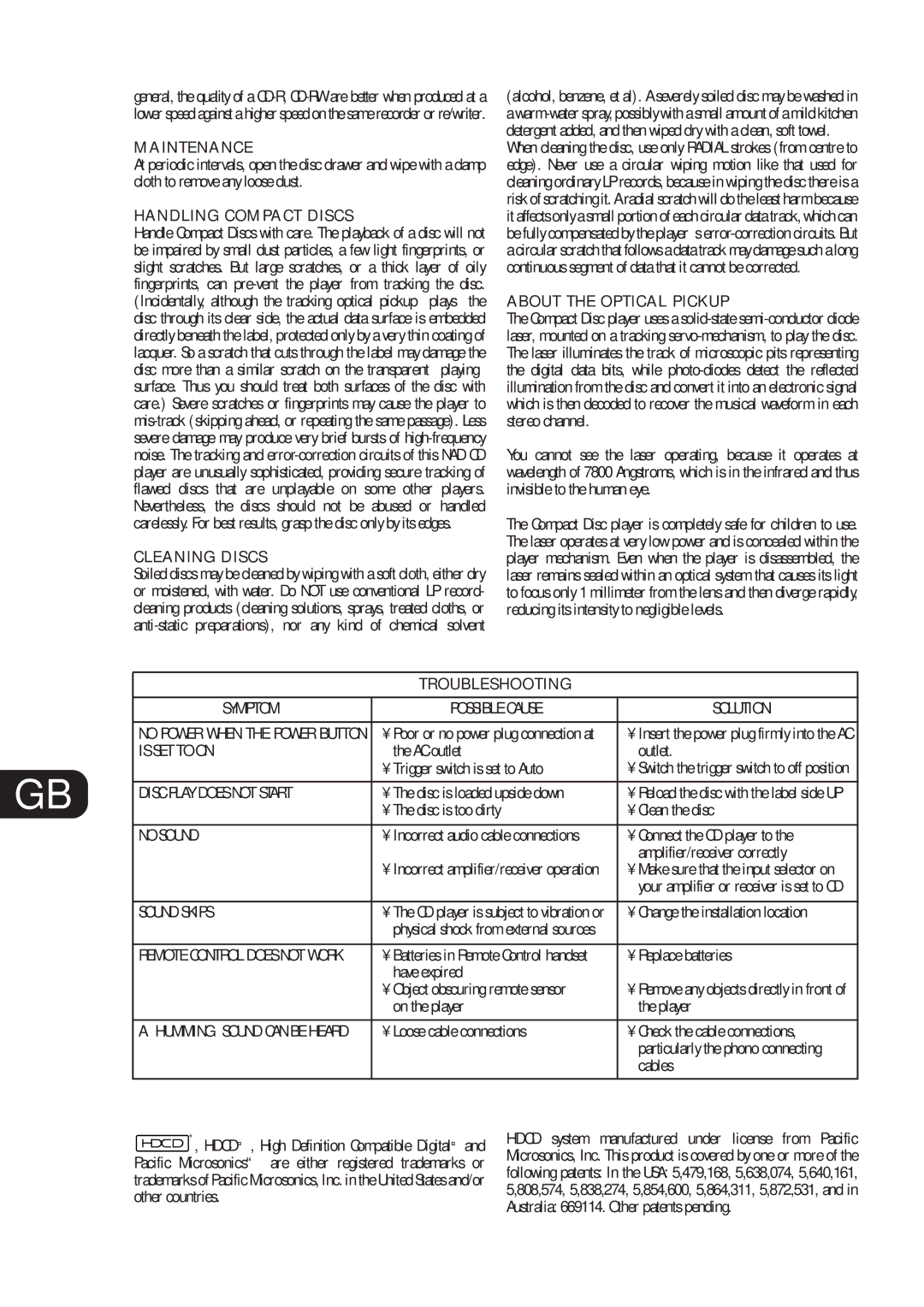
general, the quality of a
MAINTENANCE
At periodic intervals, open the disc drawer and wipe with a damp cloth to remove any loose dust.
HANDLING COMPACT DISCS
Handle Compact Discs with care. The playback of a disc will not be impaired by small dust particles, a few light fingerprints, or slight scratches. But large scratches, or a thick layer of oily fingerprints, can
CLEANING DISCS
Soiled discs may be cleaned by wiping with a soft cloth, either dry or moistened, with water. Do NOT use conventional LP record- cleaning products (cleaning solutions, sprays, treated cloths, or
(alcohol, benzene, et al). A severely soiled disc may be washed in a
When cleaning the disc, use only RADIAL strokes (from centre to edge). Never use a circular wiping motion like that used for cleaning ordinary LP records, because in wiping the disc there is a risk of scratching it. A radial scratch will do the least harm because it affects only a small portion of each circular data track, which can be fully compensated by the player’ s
ABOUT THE OPTICAL PICKUP
The Compact Disc player uses a
You cannot see the laser operating, because it operates at wavelength of 7800 Angstroms, which is in the infrared and thus invisible to the human eye.
The Compact Disc player is completely safe for children to use. The laser operates at very low power and is concealed within the player mechanism. Even when the player is disassembled, the laser remains sealed within an optical system that causes its light to focus only 1 millimeter from the lens and then diverge rapidly, reducing its intensity to negligible levels.
|
| TROUBLESHOOTING |
|
|
|
|
|
| SYMPTOM | POSSIBLE CAUSE | SOLUTION |
|
|
|
|
| NO POWER WHEN THE POWER BUTTON | • Poor or no power plug connection at | • Insert the power plug firmly into the AC |
| IS SET TO ON | the AC outlet | outlet. |
GB |
| • Trigger switch is set to Auto | • Switch the trigger switch to off position |
|
|
| |
DISC PLAY DOES NOT START | • The disc is loaded upside down | • Reload the disc with the label side UP | |
| • The disc is too dirty | • Clean the disc | |
|
|
|
|
| NO SOUND | • Incorrect audio cable connections | • Connect the CD player to the |
|
|
| amplifier/receiver correctly |
|
| • Incorrect amplifier/receiver operation | • Make sure that the input selector on |
|
|
| your amplifier or receiver is set to CD |
|
|
|
|
| SOUND SKIPS | • The CD player is subject to vibration or | • Change the installation location |
|
| physical shock from external sources |
|
|
|
|
|
| REMOTE CONTROL DOES NOT WORK | • Batteries in Remote Control handset | • Replace batteries |
|
| have expired |
|
|
| • Object obscuring remote sensor | • Remove any objects directly in front of |
|
| on the player | the player |
|
|
|
|
| A “HUMMING” SOUND CAN BE HEARD | • Loose cable connections | • Check the cable connections, |
|
|
| particularly the phono connecting |
|
|
| cables |
|
|
|
|
![]() , HDCD® , High Definition Compatible Digital® and Pacific Microsonics™ are either registered trademarks or trademarks of Pacific Microsonics, Inc. in the United States and/or other countries.
, HDCD® , High Definition Compatible Digital® and Pacific Microsonics™ are either registered trademarks or trademarks of Pacific Microsonics, Inc. in the United States and/or other countries.
HDCD system manufactured under license from Pacific Microsonics, Inc. This product is covered by one or more of the following patents: In the USA: 5,479,168, 5,638,074, 5,640,161, 5,808,574, 5,838,274, 5,854,600, 5,864,311, 5,872,531, and in Australia: 669114. Other patents pending.
8
